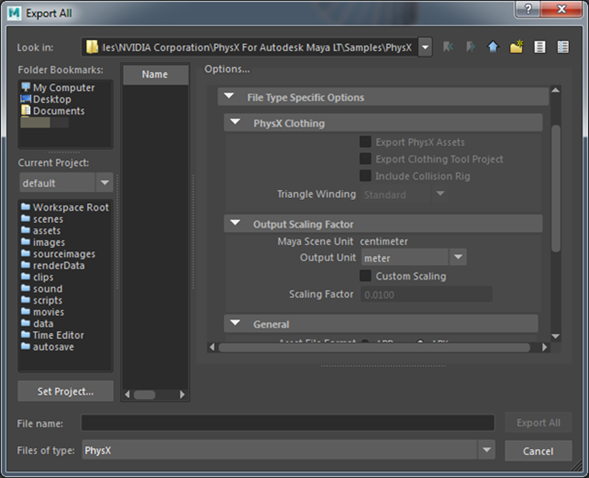Install the PhysX plug-in for your DCC tool
Included with your Stingray install, you'll find the NVIDIA PhysX plug-ins for Maya and Maya LT. For the latest Stingray, the PhysX plug-in version is now 3.3.21117.04582, and the PhysX library/SDK used is 3.3.4.
When installed and loaded, the PhysX plug-in adds a PhysX menu to the main menu bar in your DCC tool, giving you easy access to tools and documentation for creating PhysX ragdolls, rigid bodies, and constraints.
To install the PhysX plug-in for your DCC tool:
Double-click the NVIDIA_PhysX_For_<Product>_<Version>.msi located here within your Stingray install directory: \Program Files\Autodesk\Stingray\<*version*>\extras
Follow the instructions in the NVIDIA installer.
Note: In the Maya or Maya LT Help, you can find more information in the topic Enable Stingray and PhysX plug-ins.
Note: Get the PhysX plug-ins for older versions of Maya from the PhysX Plugins Download page.
When exporting PhysX data from Maya or Maya LT to Stingray, ensure you specify the correct unit scaling for export. Stingray requires the data in meters.
You’ll find that the scaling for exported PhysX data is handled in File > Export All (or Export Selected) > Output Scaling Factor. Depending on the conversion units selected in the Output Unit, the Scaling Factor displays the scale factor for the exported units. To manually add the scale factor, enable the Custom Scaling. The Output Unit is set to meter by default.

This ensures the correct correlation between meshes, PhysX actors, and global-anchored joints in Stingray with the unit or coordinate system you use in Maya, and the unit you set for your FBX scene export.
Note that the Axis Orientation is also an important consideration during export when using PhysX. If any of the PhysX data contains any globally expressed position (such as initial velocities, or free-anchor joints) these cause difficulties when simulated in Stingray. To avoid issues, export the asset in Z-Up. If your PhysX setup does not contain any of these, you can export in Y-Up or Z-Up. For example, simple meshes without PhysX constraints and Ragdolls export correctly with any coordinate system.
Stingray uses SI base units, so mass values are in kg, densities are in kg/m3, and the default density value (water) is 1000.
PhysX actors created with the NVidia PhysX plug-in for your DCC tool and exported to Stingray use grams as the base weight unit. In order to align with the units of mass expected in Stingray, these actors are converted to kg at runtime.